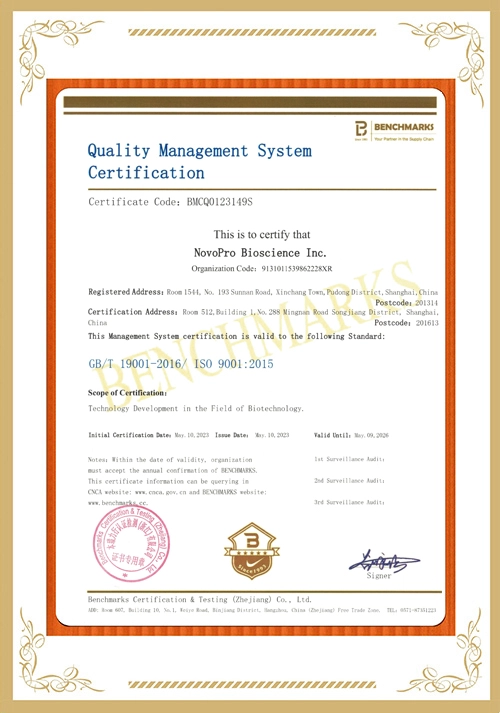-
Product Name
Anti-Cadherin-17/LI-cadherin antibody
- Documents
-
Description
Rabbit polyclonal to Cadherin-17/LI-cadherin
-
Tested applications
ELISA, WB, IHC-P, IP
-
Species reactivity
Human CDH17 / Cadherin-17
-
Alternative names
Cadherin-17 antibody; Cadherin-17 antibody; cdh17 antibody; CDH17 antibody; FLJ26931 antibody; CDH16 antibody; HPT1 antibody; HPT-1 antibody; HPT-1 antibody; HPT-1/LI antibody; LI-cadherin antibody; LI-cadherin antibody; MGC138218 antibody; MGC142024 antibody; RP23-54P14.2 antibody; HPT1 antibody; CDH16 antibody; HPT-1 antibody; HPT-1 antibody; HPT-1/LI antibody
-
Isotype
Rabbit IgG
-
Preparation
Produced in rabbits immunized with purified, recombinant Human CDH17 / Cadherin-17 (rh CDH17 / Cadherin-17; Met 1-Met 787; Q12864-1). CDH17 / Cadherin-17 specific IgG was purified by Human CDH17 / Cadherin-17 affinity chromatography.
-
Clonality
Polyclonal
-
Formulation
0.2 μm filtered solution in PBS with 5% trehalose
-
Storage instructions
This antibody can be stored at 2℃-8℃ for one month without detectable loss of activity. Antibody products are stable for twelve months from date of receipt when stored at -20℃ to -80℃. Preservative-Free.
Sodium azide is recommended to avoid contamination (final concentration 0.05%-0.1%). It is toxic to cells and should be disposed of properly. Avoid repeated freeze-thaw cycles. -
Applications
WB: 1-5 μg/mL
ELISA: 0.1-0.2 μg/mL
This antibody can be used at 0.1-0.2 μg/mL with the appropriate secondary reagents to detect Human CDH17. The detection limit for Human CDH17 is approximately 0.00975 ng/well.
IHC-P: 0.1-2 μg/mL
IP: 4-6 μg/mg of lysate
-
Background
Cadherin-17 or LI-cadherin is a member of the cadherin superfamily, genes encoding calcium-dependent, membrane-associated glycoproteins. Cadherin-17/LI-cadherin is a cadherin-like protein consisting of an extracellular region, 7 cadherin domains, and a transmembrane region but lacking the conserved cytoplasmic domain. The protein is a component of the gastrointestinal tract and pancreatic ducts, acting as an intestinal proton-dependent peptide transporter in the first step in oral absorption of many medically important peptide-based drugs. The protein may also play a role in the morphological organization of liver and intestine. Alternative splicing of the encoding gene results in multiple transcript variants. Cadherin-17/LI-cadherin preferentially interact with themselves in a homophilic manner in connecting cells. Cadherin-17 may thus contribute to the sorting of heterogeneous cell types and have a role in the morphological organization of liver and intestine. It's also involved in intestinal peptide transport. Experiments have reported the association between Cadherin-17/LI-cadherin and gastric cancer. Cadherin-17/LI-cadherin expression was detected in 63/94 of gastric adenocarcinomas in addition to intestinal metaplasia. The expression of Cadherin-17 tended to be associated with intestinal type carcinoma, and carcinomas with Cadherin-17 expression was significantly more frequent in advanced stage cases than in early stage. Cadherin-17 is also a useful immunohistochemical marker for diagnosis of adenocarcinomas of the digestive system.
-
References
- Liu LX, et al. (2009) Targeting cadherin-17 inactivates Wnt signaling and inhibits tumor growth in liver carcinoma. Hepatology. 50(5): 1453-63.
- Ito R, et al. (2005) Clinicopathological significant and prognostic influence of cadherin-17 expression in gastric cancer. Virchows Arch. 447(4): 717-22.
- Horsfield J, et al. (2002) Cadherin-17 is required to maintain pronephric duct integrity during zebrafish development. Mech Dev. 115(1-2): 15-26.
Related Products / Services
Please note: All products are "FOR RESEARCH USE ONLY AND ARE NOT INTENDED FOR DIAGNOSTIC OR THERAPEUTIC USE"

